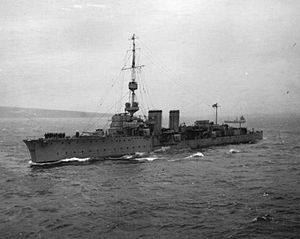HMS Castor (1915)
 |
|
| History | |
|---|---|
| Class and type: | C-class light cruiser |
| Name: | HMS Castor |
| Builder: | Cammell Laird |
| Laid down: | 28 October 1914 |
| Launched: | 28 July 1915 |
| Completed: | November 1915 |
| Commissioned: | November 1915 |
| Decommissioned: | May 1935 |
| Fate: | Sold 30 July 1936 for scrapping |
| General characteristics | |
| Displacement: | 3,750 tons |
| Length: | 446 ft (136 m) |
| Beam: | 41.5 ft (12.6 m) |
| Draught: | 15 ft (4.6 m) |
| Propulsion: |
|
| Speed: | 28.5 knots (53 km/h) |
| Range: | carried 420 tons (841 tons maximum) of fuel oil |
| Complement: | 323 |
| Armament: |
|
| Armour: |
|
HMS Castor was one of the Cambrian subclass of the C-class of light cruisers. She saw service during the First World War and the Russian Civil War.
Design of the Cambrian subclass was based on the earlier light cruisers HMS Champion and HMS Calliope, which, in turn, were based on the HMS Caroline subclass, using the same hull as the Carolines but with two funnels and a maximum armor thickness of 4 inches (102 mm) as opposed to 3 inches (76.2 mm) in the Carolines.
Castor was built by Cammell Laird at Birkenhead, England. Laid down on 28 October 1914, she was launched on 28 July 1915 and completed in November 1915.
Commissioned in November 1915, Castor was the flagship of Commodore (D), assigned to the 11th Destroyer Flotilla in the Grand Fleet. She fought in the Battle of Jutland, in which she was damaged by German gunfire and suffered 10 casualties.
On 4 October 1917, the United States Navy patrol vessel USS Rehoboth (SP-384) suffered an uncontrollable leak in her hull while on patrol duty off France. Rehoboth's crew had to be taken off, and Castor sank her with gunfire.
...
Wikipedia
